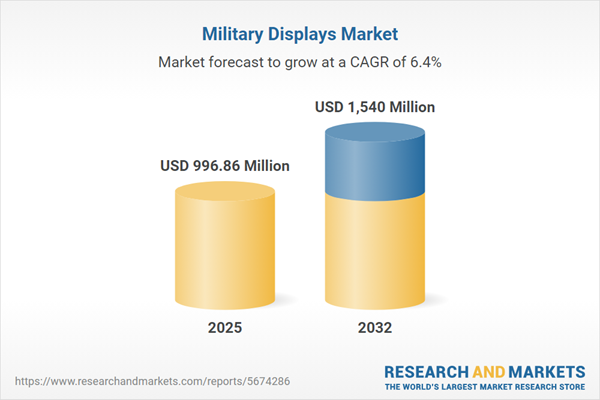Speak directly to the analyst to clarify any post sales queries you may have.
The military displays market is rapidly evolving as new technologies redefine operational effectiveness across defense environments. Sophisticated visualization solutions now form a critical backbone for command, control, and real-time decision-making, driving both competitive advantage and mission assurance.
Market Snapshot: Military Displays Market Outlook
The Military Displays Market grew from USD 935.85 million in 2024 to USD 996.86 million in 2025. It is expected to continue growing at a CAGR of 6.44%, reaching USD 1.54 billion by 2032. Expansion is fueled by increased modernization initiatives, heightened focus on situational awareness, and demand for displays able to withstand diverse operational challenges. Key stakeholders leverage advanced display formats and emerging materials to deliver robust, mission-ready systems.
Scope & Segmentation
- Display Technology: Liquid Crystal Display, Microdisplay, Digital Light Processing, Liquid Crystal on Silicon, Organic Light Emitting Diode
- Platform: Airborne, Ground, Naval, Space
- Display Type: Cockpit Display, Handheld Display, Helmet Mounted Display, Rugged Display
- Resolution: High Definition, Standard, Ultra High Definition
- Color Capability: Full Color, Monochrome
- Application: Command and Control, Navigation, Reconnaissance and Surveillance, Simulation and Training
- Regions: Americas (including North America, Latin America), Europe, Middle East & Africa, Asia-Pacific
- Key Companies: Thales S.A., Barco N.V., Leonardo S.p.A, Raytheon Technologies Corporation, L3Harris Technologies, BAE Systems, Elbit Systems, Northrop Grumman, Lockheed Martin, General Dynamics Corporation
Key Takeaways for Military Displays Market Decision-Makers
- Emerging display technologies like microdisplays and organic light emitting diode panels are shifting user expectations and enhancing visualization in complex environments.
- Integration with sensor suites and AI-driven analytics enables displays to provide contextual intelligence and predictive maintenance insights.
- Regional defense strategies, such as content localization and collaboration with domestic suppliers, shape procurement and innovation trajectories, particularly in response to shifting trade policies.
- Diverse requirements across airborne, ground, naval, and space platforms drive ongoing investment in ruggedization, resolution, and energy efficiency, tailoring solutions to unique operational needs.
- Collaboration among defense primes, niche specialists, and semiconductor partners accelerates development timelines and fosters interoperability across allied systems.
- Human-machine interface improvements and cybersecurity-centric design are increasingly central as displays are tasked with supporting real-time, secure mission execution.
Tariff Impact on Military Display Supply Chains
The 2025 introduction of new tariffs in the United States has significantly influenced sourcing strategies, causing manufacturers to pivot production processes, cultivate regional supplier partnerships, and pursue domestic testing capabilities. These changes promote long-term supply chain resilience but have elevated short-term costs and required re-certification efforts to maintain compliance with stringent military specifications.
Military Displays Market Methodology & Data Sources
Findings are based on a combination of primary interviews with system integrators, procurement officers, and display engineers, complemented by secondary analysis of technical publications, regulatory filings, and patent reviews. Trade data and scenario planning workshops further validate supply chain dynamics and regional partnership trends. Rigorous data triangulation and confidentiality standards underpin the accuracy and reliability of all research outputs.
Why This Report Matters: Senior Executive Benefits
- Identify emerging avenues to optimize supply chain robustness and reduce technology integration risks in volatile markets.
- Benchmark leading technology trends, platform requirements, and competitive moves, supporting informed investment and alliance decisions.
- Leverage actionable insights on segmentation relevance, regional adoption drivers, and collaborative ecosystems to shape future strategies.
Conclusion
As military display systems continue to evolve, embracing innovation, supply chain adaptation, and partnership-building will remain critical for defense organizations aiming to achieve operational superiority. Engaging with the insights in this report equips leaders to anticipate change and sustain mission-ready readiness.
Additional Product Information:
- Purchase of this report includes 1 year online access with quarterly updates.
- This report can be updated on request. Please contact our Customer Experience team using the Ask a Question widget on our website.
Table of Contents
3. Executive Summary
4. Market Overview
7. Cumulative Impact of Artificial Intelligence 2025
Companies Mentioned
The companies profiled in this Military Displays market report include:- Thales S.A.
- Barco N.V.
- Leonardo S.p.A
- Raytheon Technologies Corporation
- L3Harris Technologies, Inc.
- BAE Systems plc
- Elbit Systems Ltd.
- Northrop Grumman Corporation
- Lockheed Martin Corporation
- General Dynamics Corporation
Table Information
| Report Attribute | Details |
|---|---|
| No. of Pages | 185 |
| Published | October 2025 |
| Forecast Period | 2025 - 2032 |
| Estimated Market Value ( USD | $ 996.86 Million |
| Forecasted Market Value ( USD | $ 1540 Million |
| Compound Annual Growth Rate | 6.4% |
| Regions Covered | Global |
| No. of Companies Mentioned | 11 |









